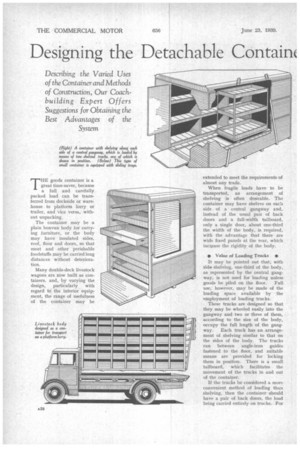Designing the Detachable Contain( For Economic Transport
Page 48

Page 49

If you've noticed an error in this article please click here to report it so we can fix it.
Describing the Varied Uses of the Container and Methods of Construction, Our Coachbuilding Expert Offers Suggestions for Obtaining the Best Advantages of the
System
THE goods container is a great time-saver, because a full. and carefully packed load can be transferred from dockside or warehouse to platform lorry or trailer, and vice versa, without unpacking.
. The container may be a plain boxvan body for carrying furniture, or the body may have insulated sides, roof, floor and doors, so that meat and other perishable foodstuffs may be carried long distances without deterioration.
Many double-deck livestock wagons are now built as containers, and, by varying the design, particularly with regard to the interior equipment, the range of usefulness of the container may be
extended to meet the requirements-of almost any trade.
When fragile loads have to be transported, an arrangement of shelving is often desirable. The container may have shelves on each side of a central gangway and, instead of the usual pair of back doors and a full-width tailboard, only a single door, about one-third the width of the body, is required, with the advantage that there are wide fixed panels at the rear, which increase the rigidity of the body.
• Value of Loading Trucks • It may be pointed out that, with sida shelving, one-third of the body, as represented by the central gangway, is not used for loading unless goods be piled on the floor. Full use, however, may be made of the loading space available by the employment of loading trucks.
These trucks are designed so that they may be wheeled easily into -the gangway and two or three of them, according to the size of the body, occupy the full length of the gangway. Each truck has an arrangement of shelving similar to that on the sides of the body. The trucks run between angle-iron guides fastened to the floor, and suitable means are provided for locking them in position. There is a small tailboard, which facilitates the movement of the trucks in and out of the container.
If the trucks be considered a more convenient method of loading than shelving, then the container should have a pair of back doors, the load being carried entirely on trucks. For a smaller container, the load may be carried on sliding trays which extend across the body. The hinge centre of the doors is right on the outer corners of the body. so that the doors may be folded back to afford a clear passage for the trays.
The container is a body without wheel-arches, consequently the height of its floor is determined by that of the floor of the vehicle which supports it, plus the thickness of the bottom framework of the container and its cross-bearers.
The unloading of a large container full of furniture would be facilitated if a hind well-floor were available. This could not be incorporated in the container, but it would be possible to provide it in the case of a platform lorry.
Such a well is supported on cranked tail-ends of the chassis and its inside width is the same as the width between the back pillars of the container.
The rear cross-hearer, also a portion of the rear part of the floor of the container, aie made removable. The hind cross-bearer has an outer flitch-plate, similar in shape to the hack plate, which is usually provided to reinforce the body here. The plate is permanently attached to the cross-bearer and it has a rightangled flap at each end, which is bolted to the back pillar and to the remaining portion of the crossbearer, under the back pillar.
These two bolts are removed when the cross-bearer is to be released. The floor of the container, over the well, is made up as a unit with strong battens on the underside. The container has a pair of fullheight doors and the lorry has a tailboard shutting up outside. This tailboard is the full depth of the well, or it may extend above the bottom of the container doors, so that the extra height provides an easy loading ramp.
The lorry, like the container, may have a removable floor-unit at the rear. This is placed over the well if, at any time, the lorry be required to be used as a plain platform.
The simplest " container " is a platform or flat, of the type which is largely used in the Lancashire cotton • trade. Such a means for transport simplifies the "returned-empty problem."
e Dispensing With a Roof • Somewhat more elaborate, but yet easily packed flat, is a sided container without a roof, although if the goods concerned require protection a 'waterproof sheet may be added. This sided container has a strong
• bottom frame with a pair of lifting shackles, each side connected by a bar which runs underneath the container. There is a tailboard, hinged in the usual manner, whilst the opposite end and both sides hinge inwards when the container is to be packed flat.
First, the sides are folded inwards, one side being hinged higher than the other, so that due allowance is made for the thickness of the side first folded. Then the tailboard is removed by sliding it endwise off its pin-plates, and it is laid on top of the sides. Lastly, the inwardly hinged end is folded on top. Like the sides, it is hinged at the appropriate height, so that it folds horizontally.
In order that the projections of the inside hinges do not obstruct the load, the sides and end are made up of a double thickness of boards. The inside boards are of the same thickness as the projection of the hinges and thus a flush surface is formed.












































































